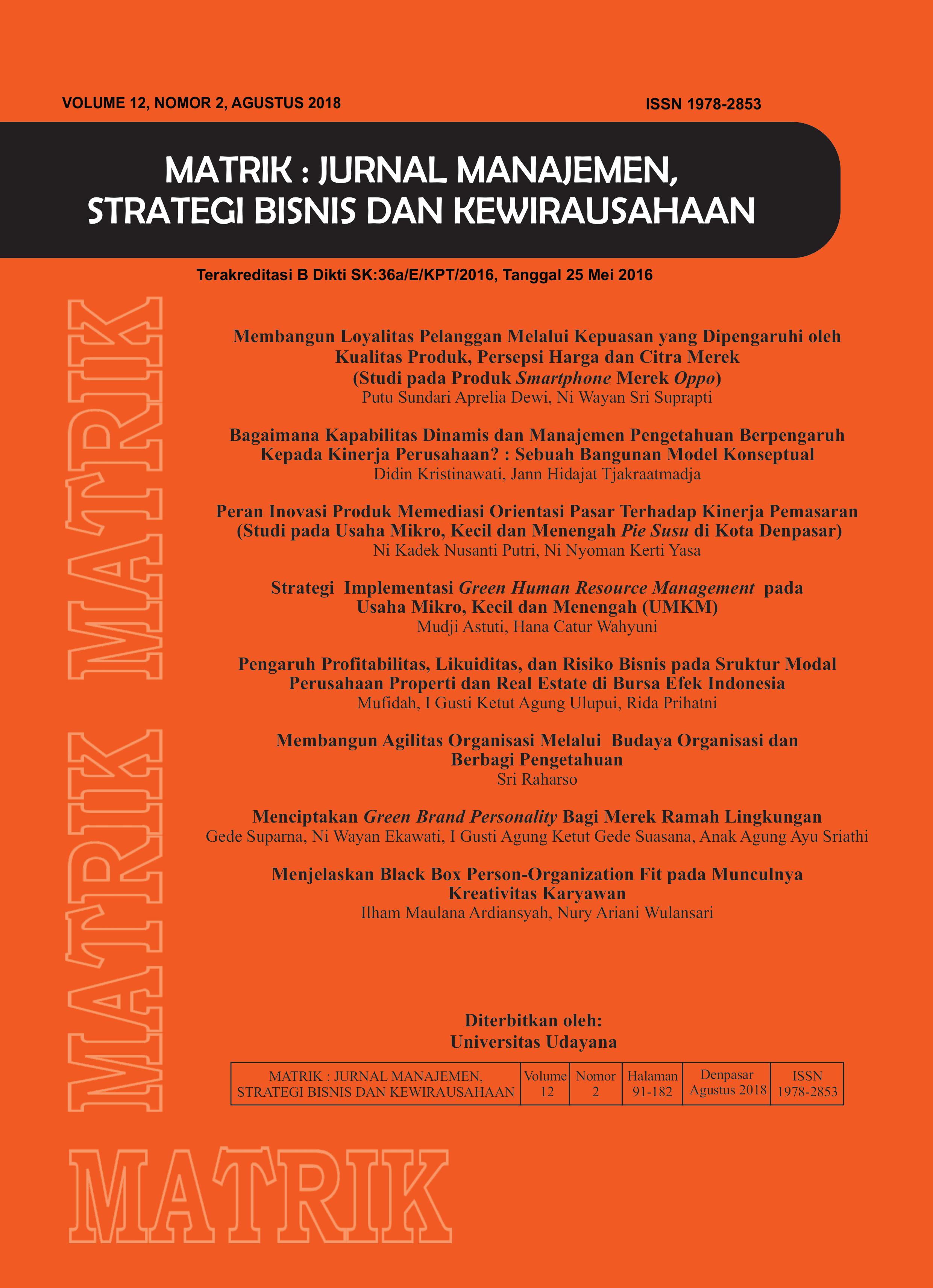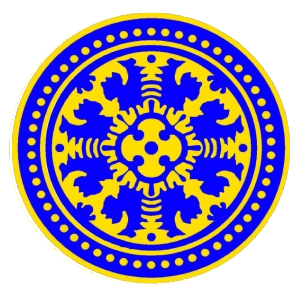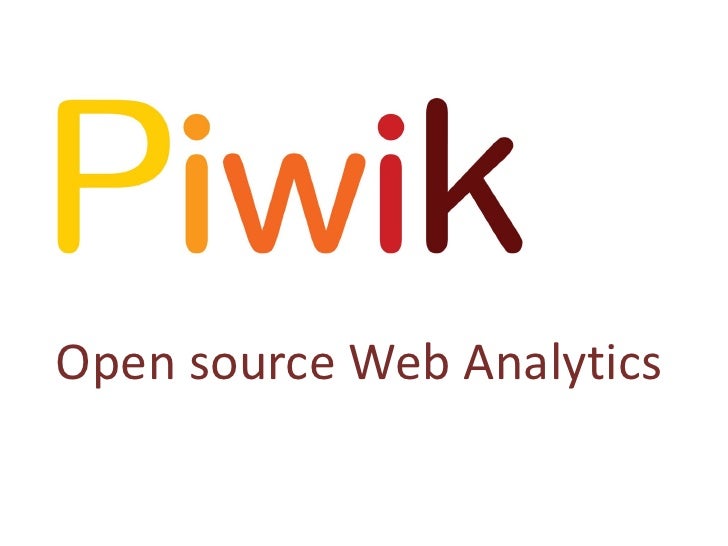BAGAIMANA KAPABILITAS DINAMIS DAN MANAJEMEN PENGETAHUAN BERPENGARUH KEPADA KINERJA PERUSAHAAN? : SEBUAH BANGUNAN MODEL KONSEPTUAL
Abstract
ABSTRACT
This study is aimed to develop a conceptual relationship between knowledge management and dynamic capabilities that will affect organizational performance. Knowledge is acquired, transferred, internalized, and combined through formal and informal processes in the SECI model will generate new knowledge for the organization. However, the knowledge repository per se is insufficient to boost performance. It needs a company's ability to create, integrate, modify and utilize its knowledge assets. The ability itself is the result of learning and practice within a company. Therefore, the factors that will create effective knowledge management process need to be facilitated by the company, which are related to learning culture, mistrust, and information technology support. In addition to the model, in the era of rapidly changing environmet, it is necessary to build members of organizations with t-shaped skill character namely expert in the knowledge specification as well as open-minded and capable to cooperate in cross-division.
Keywords: dynamic capability, knowledge management, learning habitat, performance, t-shaped skill
Downloads
References
American Productivity & Quality Center. (1996). Knowledge Management. Houston, Texas: Amer Productivity Center .
Amit, R., & Schoemaker, P. J. H. (1993). Strategic assets and organizational rent. Strategic Management Journal. https://doi.org/10.1002/smj.4250140105
Barney, J. (1991). Barney 1991.pdf. Journal of Management.
Barreto, I. (2010). Dynamic Capabilities: A review of past research and an agenda for the future. Journal of Management. https://doi.org/10.1177/0149206309350776
Bergeron, B. (2003). Essentials of Knowledge Management. New York: John Wiley and Sons Ltd.
Bhatt, G. D., & Grover, V. (2005). Types of Information Technology Capabilities and Their Role in Competitive Advantage: An Empirical Study. Journal of Management Information Systems. https://doi.org/10.1080/07421222.2005.11045844
Cepeda, G., & Vera, D. (2007). Dynamic capabilities and operational capabilities: A knowledge management perspective. Journal of Business Research. https://doi.org/10.1016/j.jbusres.2007.01.013
Chien, S., & Tsai, C. (2012). Dynamic capability, knowledge, learning, and firm performance. Journal of Organizational Change Management. https://doi.org/10.1108/09534811211228148
D’Este, P. (2002). The distinctive patterns of capabilities accumulation and inter-firm heterogeneity: the case of the Spanish pharmaceutical industry. Industrial and Corporate Change. https://doi.org/10.1093/icc/11.4.847
Davenport, T. H., & Prusak, L. (1998). Working Knowledge: How Organizations Manage What They Know. Knowledge Creation Diffusion Utilization. https://doi.org/10.1109/EMR.2003.1267012
Drucker, P. (1998). From capitalism to knowledge society. The Knowledge Economy. https://doi.org///doi.org/10.1016/B978-0-7506-0921-0.50006-9
Drucker, P. F. (1994). The Post-Capitalist Society. Post-Capitalist Society. https://doi.org/10.1016/B978-0-7506-0921-0.50001-X
Eisenhardt, K. M., & Martin, J. E. (2000). Dynamic Capabilities: What are they? Strategic Management Journal. https://doi.org/10.1002/smj.233
Eisenhardt, K. M., & Santos, F. M. (2002). Knowledge-Based View: A New Theory of Strategy? Handbook of Strategy and Management. https://doi.org/10.4135/9781848608313
Grant, R. M. (2010). Contemporary Strategy Analysis: Text & Cases. International Journal of Management Education. https://doi.org/10.1111/j.1467-9310.2006.00453_1.x
Griffith, D. A., Noble, S. M., & Chen, Q. (2006). The performance implications of entrepreneurial proclivity: A dynamic capabilties approach. Journal of Retailing. https://doi.org/10.1016/j.jretai.2005.11.007
Gurteen, D. (1998). Knowledge, Creativity and Innovation. Journal of Knowledge Management. https://doi.org/10.1108/13673279810800744
Harkins, P., Carter, L., & Timmins, A. J. (2000). Linkage, Inc.’s best practices in knowledge management and organizational learning handbook : case studies, instruments, models, research. Lexington, MA: Linkage Incorporated.
Hartanto, F. M. (2009). Paradigma Baru Manajemen Indonesia: Menciptakan Nilai dengan Bertumpu pada Kebajikan dan Potensi Insani. Bandung: Mizan.
Helfat, C. E., Helfat, C. E., Peteraf, M. a, & Peteraf, M. a. (2003). The dynamic resource based view: Capability lifecycles. Strategic Management Journal.
Ikujiro Nonaka, H. T. (1995). The Knowledge-Creating Company - Ikujiro Nonaka, Hirotaka Takeuchi - Oxford University Press.
Katkalo, V. S., Pitelis, C. N., & Teecey, D. J. (2010). Introduction: On the nature and scope of dynamic capabilities. Industrial and Corporate Change. https://doi.org/10.1093/icc/dtq026
Kazimierz Krzakiewicz. (2013). Dynamic capabilities and knowledge management. Management , 17(2), 1–15. https://doi.org/DOI10.2478/manment-2013-0051
Lee, H., & Choi, B. (2003). Knowledge management enablers, processes, and organizational performance: An integrative view and empirical examination. Journal of Management Information Systems. https://doi.org/10.2307/40398621
Leonard-Barton, D. (1995). Wellspring of knowledge. Boston: Harvard Business School, 1–17.
Maier, R., & Hädrich, T. (2006). Centralized versus peer-to-peer knowledge management systems. Knowledge and Process Management. https://doi.org/10.1002/kpm.244
Nelson, R., & Winter, S. (1982). An Evolutionary Theory of Economic Change. Belknap Press: Cambridge, MA.
Nonaka, I., & Takeuchi, H. (1995). Knowledge-Creating Company. Knowledge-Creating Company. https://doi.org/10.1016/S0969-4765(04)00066-9
Penrose, E. (1959). The Firm in Theory. In The Theory of the Growth of the Firm. https://doi.org/10.1093/0198289774.001.0001
Porter, M. E. (1979). How Competitive Forces Shape Strategy. Harvard Business Review.
Prahalad, C. K., & Hamel, G. (1990). The core competencies of the corporation. Harvard Business Review. https://doi.org/100-003-757
Raven, A., & Prasser, S. G. (1996). Information Technology Support for the Creation and Transfer of Tacit Knowledge in Organizations. In Americas Conference on Information Systems (AMCIS) (p. 177). AMCIS. Retrieved from http://aisel.aisnet.org/amcis1996/177
Spencer, L. M., & Spencer, S. M. (1993). Competence at Work : Models for Superior Performance. John Wiley & Sons.
Sveiby, K. (1997). The Intangible Assets Monitor. Journal of Human Resource Costing & Accounting. https://doi.org/10.1108/eb029036
Teece, D. (2007). Explicating dynamics capabilities: The nature and microfundations of (sustainable) enterprise performance. Strategic Management Journal. https://doi.org/10.1002/smj.640
Teece, D. J., Pisano, G., & Shuen, A. (2000). Dynamic Capabilities and Strategic Management. In Nature & Dynamics of Organizational Capabilities.
Teece, D. J., Rumelt, R., Dosi, G., & Winter, S. (1994). Teece, D. J., Pisano, G., Shuen. A. 1997 Dynamic capabilities and strategic management, SMJ 18(7) 509-533.pdf. Journal of Economic Behavior & Organization. https://doi.org/10.1016/0167-2681(94)90094-9
Thorpe, R., Holt, R., Macpherson, A., & Pittaway, L. (2005). Using knowledge within small and medium-sized firms: A systematic review of the evidence. International Journal of Management Reviews. https://doi.org/10.1111/j.1468-2370.2005.00116.x
Tjakraatmadja, J. H. (2002). Manajemen Transformasi Pengetahuan dalam Tim dan Organisasi Pembelajar. Institut Teknologi Bandung.
Tjakraatmadja, J., & Kristinawati, D. (2017). Strategi Implementasi Knowledge Management (1st ed.). Bandung: Penerbit ITB.
Tseng, S., & Lee, P. (2014). The effect of knowledge management capability and dynamic capability on organizational performance. … of Enterprise Information Management. https://doi.org/10.1108/JEIM-05-2012-0025
Ulrich, D., & Lake, D. (1991). Organizational capability: Creating competitive advantage. Academy of Management Executive, 5(1), 77–92. https://doi.org/10.5465/AME.1991.4274728
Ulrich, D., & Smallwood, N. (2004). Capitalizing on capabilities. Harvard Business Review. https://doi.org/Article
UN. (2014). Undp Knowledge Management Strategy Framework 2014 -2017. United Nations Development Programme.
Venkatraman, N., & Ramanujam, V. (1986). Measurement of business performance in strategy research: A comparison of approaches. The Academy of Management Review.
Wang, C. L., & Ahmed, P. K. (2004). The development and validation of the organisational innovativeness construct using confirmatory factor analysis. European Journal of Innovation Management. https://doi.org/10.1108/14601060410565056
Wernerfelt. (1984). A Resource-based view of the firm. Wernerfelt, B. (1984). A Resource-Based View of the Firm. Strategic Management Journal. https://doi.org/10.1002/smj.4250050207
Zahra, S. A., & George, G. (2002). Absorptive capacity: A review, reconceptualization, and extension. Academy of Management Review. https://doi.org/10.5465/APBPP.2000.5438568
Zahra, S., Sapienza, H., & Davidsson, P. (2006). Entrepreneurship and dynamic capabilities: A review, model and research agenda. Journal of Management Studies. https://doi.org/10.1111/j.1467-6486.2006.00616.x
Zollo, M., & Winter, S. G. (2002). Deliberate learning and the evolution of dynamic capabilities. Organizational Science. https://doi.org/10.1287/orsc.13.3.339.2780
 This work is licensed under a Creative Commons Attribution-ShareAlike 4.0 International License.
This work is licensed under a Creative Commons Attribution-ShareAlike 4.0 International License.

















